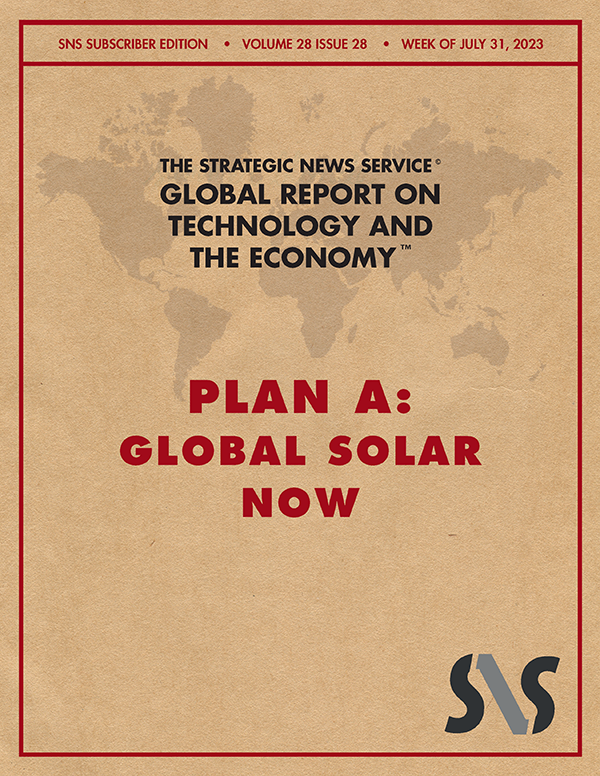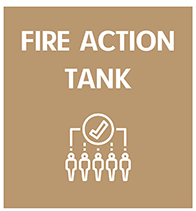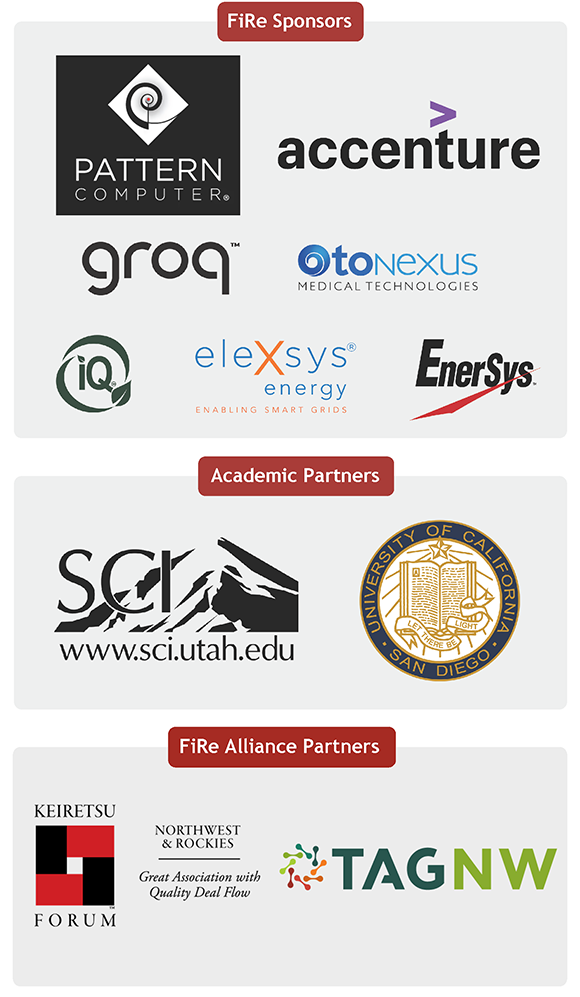
PLAN A: GLOBAL SOLAR NOW By Evan Anderson Register for Future in Review now to take advantage of our summer pricing at $4,900. The price jumps up to $5,900 starting Sept 1. _______ Why Read: This summer, the beginning of an El Niño cycle has heralded a new climate shift on our planet. As we enter an era of rapidly intensifying climate change, it is clearer with each passing month that something must be done, and without delay. This week, we cover what that can and should be in the immediate future - our Plan A - and introduce the CTO Design Challenge topic for our Future in Review (FiRe) 2023 conference in November. We are now in a fight for our livelihoods and our lives. If you have thoughts, resources, or applicable skillsets to offer (energy, solar, batteries, policy, finance, international business experience, etc.), reach out to the SNS Team to work with us on the fight. And join us at FiRe 2023 to contribute to the challenge live and help formulate our plan of attack to get us down from the ledge of climate crisis: our Plan A.
Introduction Fire that's closest kept burns most of all. - William Shakespeare, "The Two Gentlemen of Verona" The world is too much with us; late and soon. [. . .] - William Wordsworth For decades, we have been warned. By biologists deep in the Amazon; by oceanographers in the atoll reefs of the South Pacific. By ornithologists, entomologists, zoologists, glaciologists, firefighters, farmers, and forecasters. We are burning up. Between deforestation, the rampant burning of fossil fuels, industrial output, and the increasingly severe resulting feedback loops in the natural world, the world is indeed too much with us. The year 2023 has seen countless climate disasters, lives lost across many species, and records broken. We are on a rapidly accelerating downward spiral. Our carbon emissions are now directly tied to what stays in the atmosphere: the planet's ability to keep up was left behind at the turn of the last century:
This spiral is most easily understood by looking at the planet's energy balance. In raw energy alone, it is important to note that our pale-blue dot is taking on far more energy than it did before we came along and began to burn things. (In the following graphs, ZJ=1021 joules.)
Source: von Schuckmann et al., 2023 How fast, exactly, are we spiraling? As the onset of a new El Niño cycle has begun, the first half of 2023 has seen the most extreme effects of anthropogenic climate change ever measured, across a broad swathe of categories, packed into a six-month period. Let's first discuss the implications of what we're seeing on the ground today, and then (I promise, dear readers) we will get to the most interesting part: the solution.
The data collected around the world this year has thrown climate change into new and stark relief. Gone are the days of speculation about how long we might have until our little planet can no longer absorb the massive increases in energy we have forced upon it. We are entering a new era, one in which the world that was, is no longer. There are four top categories to keep an eye on: ice, fire and heat (interrelated), and flooding. Arctic and Antarctic Ice First, let's be clearer about nomenclature. Our ice caps are not "melting"; they are increasingly "melted." What do I mean by this? Planetwide, this year saw the hottest July ever recorded. With the heat, ice melt in Greenland skyrocketed. Levels are far above previously recorded melt - and we were already in a steady upward trend.
Source: National Snow and Ice Data Center Greenland's ice sheet holds enough potential meltwater to raise sea levels 23 feet - so a drastic acceleration is deeply concerning.
Photographer Paul Souders, friend of SNS and author of the award-winning book Arctic Solitaire, aboard the Ocean View (center) in the region of Greenland's ice pack, this week. So, too, though, are Antarctica's sea-ice levels hitting a tipping point. Annual sea-ice totals had previously increased slightly every year until 2014. By 2015, they had begun to decrease. But this year something entirely different is happening: 2022 saw a decrease in ice extent that was solidly below the previous average. So far, 2023 has already seen that decrease more than double.
Keep in mind, this massive decrease is occurring during the winter in the Southern Hemisphere, when ice extent should be growing. There is therefore likely to be far less sea ice over the entire year, as the trend continues. We are currently looking at a missing amount of surface-area coverage roughly the size of the landmass of Argentina. Exacerbating the situation are lost albedo, exposure of land ice (which would cause more sea-level rise if it were to melt) in Antarctica, and higher temperatures and damage to species. But levels of ice in Greenland and Antarctica and potential sea-level rise are really (dare I say it?) long-term problems. In time, they will destroy our coastal cities and countless trillions of dollars in assets, sure - but we have bigger problems on the immediate horizon. Fire & Heat Heatwaves in the summer of 2023 have been the worst on record. Temperatures in Iran on the Persian Gulf reached 66 degrees Celsius (~151 Fahrenheit), confirming fears that the region may soon be too hot to support human life outdoors. As I write this, Chile, racked by wildfire all summer, is now experiencing temperatures of 38.9C (~102 Fahrenheit). This is in the Andes. In midwinter.
This year has also seen an unprecedented level of uncontained wildfire. In Canada, more than 1,000 active fires were burning across the entire nation as of August 1, with more than 13 million hectares (50,000 square miles) scorched so far, sending clouds of smoke across the continent and into the United States. That's an area larger than Kentucky, and summer isn't half over yet.
In Greece, wildfires torched resorts, homes, and towns on the islands of Rhodes and Corfu as tens of thousands of people were forced to evacuate due to the speed and ferocity of the fires. Meanwhile, in Italy, powerful ice storms in the north contrasted sharply with a triple threat in Sicily. First, a heatwave that reached 46C (~115 Fahrenheit) knocked out power, overtaxing the system and raising concrete temperatures to 50C (122 Fahrenheit), melting the underground transmission cables laid in the street. Loss of power led to the loss of running water. Wildfires then broke out across the island, trapping residents of Catania inside an area without air conditioning or water available. In the world's oceans, temperatures have soared as well. The Atlantic meridional overturning circulation (AMOC) is a deep current that churns oxygen and nutrients to the depths of the Atlantic, keeps the United Kingdom warm, and affects rainfall patterns and heat around the entire Atlantic region. It now appears to be slowing down. The potential effects of this are myriad and highly unpredictable. In shallower waters, excess heat has blown previous records away. Waters in the Florida Keys hit 101.1 Fahrenheit this July, while the Mediterranean set a new record of 28.71 Celsius (~84 Fahrenheit). And temperatures have been much higher than average in many more places. According to CBS News: The National Oceanic and Atmospheric Administration in late June warned that half of the world's oceans may experience marine heat wave conditions by September. Research scientist Dillon Amaya said that in the organization's Physical Sciences Laboratory's decades of measurement, such widespread high temperatures had never been seen. "Normally, we might expect only about 10% of the world's oceans to be 'hot enough' to be considered a marine heatwave, so it's remarkable to reach 40% or 50%, even with long-term warming," Amaya said. Global sea temperatures in May and June were at record highs for the time of year. The temperatures [were] also "much higher than anything the models predicted," Dr. Michael Sparrow, head of the World Meteorological Organization's world climate research department, said. This is not good - in particular, because the rapid destruction of reefs and superheating of ocean waters makes our oceans much more unlivable for the fish and other species that more than 3 billion people rely on for survival. Marine heatwaves of significant-enough scope could eventually lead to mass famine. But the shift in where heat was and is now also affects food supplies on land. A recent study by researchers in the US and Germany published in Nature Communications found that the jet stream is now wavering more often than ever before. The ensuing changes in precipitation and heat threaten to cause simultaneous crop failures as multiple breadbasket regions are hit at the same time, for the same reason. Indeed, the US wheat crop has already suffered badly, along with soy. Corn in the US is under threat. At the same time, tomato prices in India have skyrocketed following heatwaves on the Indian Subcontinent, while drought has decimated the Arab Maghreb and Spain, and spring crops across the UK, Germany, and Eastern Europe have all been hit hard this year. Generally speaking, the soil is increasingly too dry in summer and too wet in winter to maintain previous yields across a number of crops. Flooding On the topic of too much water: flooding has also increased in scale and scope in 2023 far beyond previous standards. This year has seen massive flooding across the Eastern US, with a 1,000-year flood dropping 8 inches of rain in the Hudson Valley in a single day. The US Northeast is seeing far worse floods than it used to - extremes that are exactly what climate scientists predicted would happen. As recently reported by Vox (7/17/23): "It's worse than a new normal. I call it a new abnormal," says University of Pennsylvania climate scientist Michael Mann. This weekend, the Philadelphia suburbs were hit with heavy flash flooding that inundated roads and killed five people. Earlier this month, Vermont also experienced heavy flooding that trapped people in their homes and damaged roads and buildings. [. . .] "Everywhere is susceptible to these impacts," Mann said. "The western, central, and eastern US, Europe, and Asia - with one of the best examples being the Pakistan floods last year which displaced more than 30 million people." The 2022 floods in Pakistan were particularly damaging, given the vastness of the affected area and lack of infrastructure. But the heavy monsoon rains in South Korea proved that good drainage cannot always save you. At the end of July, massive flooding in Beijing overwhelmed the city's infrastructure, dropping what would normally be a month's worth of rain in three days. Subways, airports, and roads were closed down. According to a Beijing resident quoted by NBC News: "This is not the first time I have seen such a heavy rain, but there has not been such a severe flood. [. . .] Residential areas are without water because pumping stations are flooded. [. . .]" Ok, that's enough. The point here is not doom and gloom. The common thread among these sets of disasters is that their speed, ferocity, and variability are far more damaging and threatening than we had anticipated. This is the new, accelerated era of climate change, and it works on its own clock. The Intergovernmental Panel on Climate Change (IPCC) reports of old are long gone: you can throw out the old plans with the 30-year timelines for dealing with climate change. It's clear now that those plans are 25 years late and a few trillion dollars short. We don't have 30 years to figure this out; we have 5. So what do we do?
As seasoned SNS members and FiRe conference participants are aware, we often launch special projects when we believe an issue is critical enough to warrant timely attention. A recent example is a working group established by FiRe COO Berit Anderson, which, over one-and-a-half years, through a series of roundtable discussions, built a plan to get the United States grid to net-zero. FiRe 2022 attendees may remember the release of the "Action Plan for US Energy Independence" on the virtual stage last year. The plan is posted in its entirety here. From that report: Constraint #1: We Have Less Than 30 Years to Transition The biggest and most important constraint facing our transition to 100% renewable energy is time. The US has less than 30 years to make this transition. And not only do we need to transition our current energy supply - we also need to increase our capability to generate energy overall by 2x-3x in order to meet the demand expected from electrifying transportation, building heating and cooking, manufacturing, construction, and shipping. In fact, it is now increasingly apparent that we have far less than 30 years, having already surpassed the IPCC's 1.5 Celsius target; and we will likely be in that territory for the next five years. This temperature boundary was set because the impacts of climate change past that mark begin to threaten our ability to maintain a stable society. As described by the Washington Post's Sarah Kaplan: Beyond that threshold, scientists have found, climate disasters will become so extreme that people will not be able to adapt. Basic components of the Earth system will be fundamentally, irrevocably altered. Heat waves, famines and infectious diseases could claim millions of additional lives by century's end. It is now pretty clear that this will be the case. The good news is that even given a shorter timeline, the guidance formulated by the energy-independence working group is solid. We just have to fit that plan into a much shorter time span. Again from the report: If we simply follow the existing process - gaining the necessary rights-of-way, building transmission lines, securing permits for centralized renewables, and constructing wind and solar farms - we will not meet the goal of a 50% renewable-energy supply by 2030. Typical rollout time for electric-line projects necessary to transmit power from as-yet-unbuilt solar and wind farms is approximately 10 years. We have only eight years to reach the interim 50% goal. Adding to urgency is the fact that, in the last 10 years, only four out of five centralized renewable projects planned for the Western US were actually completed. The rest fell victim to permitting, routing, and other regulatory hurdles. Even if we somehow manage to triple our current centralized renewable-energy capabilities by 2050, that gets us only halfway. We would also then need to develop 3x the transmission infrastructure, substations, and distribution infrastructure to deliver that energy - another extremely expensive and time-intensive process. By definition, a huge percentage of the improvement in the next few years must emanate from something other than the current centralized approach. In order to maximize the use of renewable energy and increase the resilience of America's power supply, we will need to transition to a fully two-way grid. The group's findings were on target. But continuing, our assessment is that we now have just five years in which to get this done. Not only is there no time left in which to argue the respective benefits of developing new hydrogen solutions, nuclear-plant development on a 20-year timeline, or cold fusion - we don't even have time to deploy existing renewable solutions on the schedule we have been counting on to date. So, what are we getting at here? What is Plan A? Like all good plans, Plan A is extremely simple. It goes like this: Build out solar solutions as they exist today, as fast as we can, and install them in every way possible, until we have doubled the planet's electricity supply. The reason we call this Plan A is that it can work now. It is not exclusive of other plans - but if we start here, it can work now. By installing and microgridding solar (with battery storage) in the next five years on every rooftop, in every vacant lot, and over every irrigation canal, parking lot, and pool cabana on the planet, we can generate more than enough energy to achieve our mutual ultimate goal: generating double current consumption, which is at roughly 25 terawatt hours. Finder just happens to have made a back-of-envelope calculation tool that already shows us how many square miles we need to power the world currently; we just need to double that. This solution is elegant for the following reasons:
To implement Plan A, we will need to:
That's all. Simple, right?
The FiRe 2023 CTO Design Challenge Between the idea And the reality Between the motion And the act Falls the Shadow - T.S. Eliot, "The Hollow Men" Those members who have attended our annual Future in Review conference are familiar with the CTO Design Challenge. For others: each year, we invite a group of technically minded, rather ingenious individuals to solve an overwhelmingly challenging, but achievable, goal onsite at FiRe. (They do not all have to be CTOs.) In the past, this has led to a new solution for fighting urban wildfires (since implemented in San Diego County), the creation of the INVNT/IP consortium, and the launch of Pattern Computer, among other actionable achievements. This year, we are dedicating the Challenge to "Plan A: Five to Thrive." In these pages, I have explained reasons for implementing the plan starting immediately, why the focus should be rapid deployment of solar and microgrids, and the beginnings of a gameplan (not yet fully fleshed-out). Even with our full confidence in the FiRe CTO Challenge, we need the help of many. This will not be a one-off event. This is a multiyear project. If you have relevant skills in solar, battery technology, microgrids, public utilities, energy policy, international negotiations, diplomacy, or just a damn good mind for engineering, we need you. We have run out of rope for inaction. We cannot lounge comfortably between the idea and the reality any longer. The Shadow is indeed upon us. It is time to step out, into the sun. Reach out, join the challenge, and help us make Plan A work so well that everything else we develop for energy abundance over the next few decades is icing on top.
Your comments are always welcome. Sincerely, Evan Anderson evan@stratnews.com Email sent to SNS may be reprinted, unless you indicate that it is not to be. We encourage you to forward your favorite issues of SNS to a friend(s) or colleague(s), 1 time per recipient, provided that you cc: info@strategicnewsservice.com and that sharing does not result in the publication of the SNS Global Report or its contents in any form except as provided in the SNS Terms of Service (linked below). To arrange for a speech or consultation by Mark Anderson on subjects in technology and economics, or to schedule a strategic review of your company, email mark@stratnews.com. For inquiries about Partnership or Sponsorship Opportunities and/or SNS Events, please contact Berit Anderson, SNS COO, at berit@stratnews.com.
* On September 19-21, Mark will be keynoting the Info-Tech LIVE 2023 Conference at the Cosmopolitan Hotel in Las Vegas, along with Geoffrey Hinton, Ray Kurzweil, and a few other tech friends. * And on November 6-9, he will be hoping to see many of our members in person, at the FiRe 2023 conference, now in its 20th year, at the Terranea Resort.
Copyright 2023 Strategic News Service LLC "Strategic News Service," "SNS," "Future in Review," "FiRe," "INVNT/IP," and "SNS Project Inkwell" are all registered service marks of Strategic News Service LLC. ISSN 1093-8494 |





















